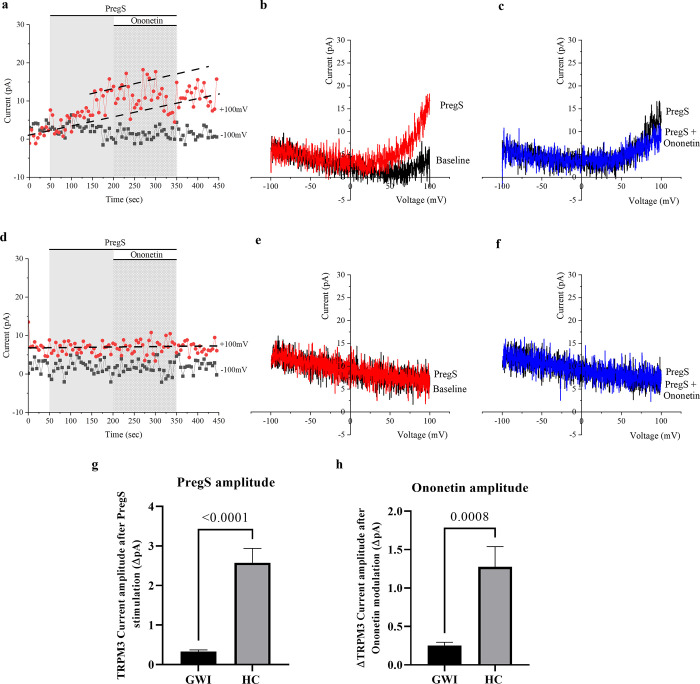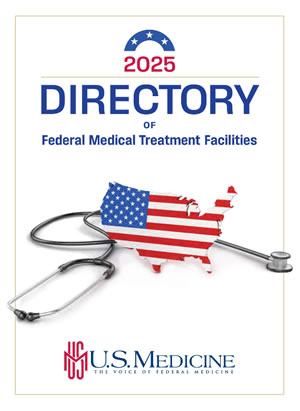
Click to Enlarge: Representation of TRPM3 ion channel activity in NK cells from HC and GWI participants (whole-cell patch-clamp). a, b, c —Current obtained in whole-cell patch-clamp condition in a NK cell from a HC participant. (a) A representative time-series of current amplitude at +100 mV and −100 mV. (b) I–V curve before and after 100 μΜ PregS stimulation. (c) I–V curve on PregS stimulation and after modulation with 10 μΜ Ononetin in the presence of PregS. d, e, f —Current obtained in whole-cell patch-clamp condition in a NK cell from a GWI participant. (d) A representative time-series of current amplitude at +100 mV and −100 mV. (e) I–V curve before and after 100 μΜ PregS stimulation. (f) I–V curve on PregS stimulation and after modulation with 10 μΜ Ononetin in the presence of PregS. g–h: Bar graphs representing TRPM3 current amplitude at +100 mV, (g) is regarding TRPM3 stimulation with 100 μΜ PregS in GWI (N = 6; n = 47) compared with HC participants (N = 6; n = 48), while (h) is regarding TRPM3 modulation with 10 μΜ Ononetin in the presence of PregS in GWI (N = 6; n = 42) compared with HC participants (N = 6; n = 39). Dash-lines in time-series illustrate the baseline and PregS effects. N refers to number of participants and n to number of records analysed. Data presented as mean ± SEM and determined by Mann-Whitney U test. Abbreviations: GWI, Gulf War Illness; HC, healthy control; NK, natural killer; PregS, pregnenolone sulfate. Source: PLoS One
QUEENSLAND, AUSTRALIA — Veterans suffering from Gulf War illness (GWI), also known as Gulf War Syndrome (GWS), have faulty cell function that is likely caused by intense exposure to hazardous biological and chemical agents during war service, according to a new study.
The study published in PLOS ONE evaluated transient receptor potential melastatin 3 (TRPM3) ion channel activity in natural killer (NK) cells from Gulf War illness participants in comparison with the same cells from healthy controls. Study authors are affiliated with Griffith University in Queensland, Australia.1
Gulf War illness is a “chronic, debilitating, and multisystem disorder that affects people who served in the Gulf War. Nearly one million service members from more than 40 countries engaged in combat in the Gulf War in 1990 and 1991 and were exposed to an array of known and unknown or undefined hazardous environmental stressors and biological and chemical agents (insecticide, pesticide, insect repellent, organophosphate nerve agents, smoke from oil-well fires, depleted uranium). To reduce risk, prophylactic strategies, several mandatory vaccines and drugs were administered concurrently. Though servicemembers returned from the Gulf War more than three decades ago, it’s estimated that 25% to 32% of Gulf War veterans continue to suffer from health issues and disabling symptoms likely caused by exposures during the Gulf War,” the study authors explained.
These symptoms include “chronic fatigue, pain, inflammation, sleep disturbances, neurological and cognitive impairment, gastrointestinal and respiratory disorders, and post-exertional malaise, but not all affected individuals develop every symptom, which makes diagnosis difficult. The causes of Gulf War illness aren’t completely understood, but evidence suggests the most reasonable cause is exposure to a combination of toxicant agents (insecticide, pesticide, insect repellent, organophosphate nerve agents, smoke from oil-well fires, depleted uranium) and prophylactic strategy,” according to the authors.
The authors pointed out “the symptoms of Gulf War Illness significantly overlap Myalgic Encephalomyelitis/Chronic Fatigue Syndrome (ME/CFS), fibromyalgia and long COVID-19, which all have complex mechanisms that are only partially defined. In previous studies, the researchers demonstrated the role of transient receptor potential ion channels in the pathophysiology of ME/CFS. This is the first analysis of TRP channel function in veterans with Gulf War Illness, and the authors selected TRPM3 as the first TRP channel to be investigated due to TRPM3’s association with ME/CFS. However, other TRP channels may also be associated with the symptomatology presented by patients with Gulf War Illness.”
The study participants, who were recruited between June 6, 2023, and Nov. 30, 2023, included individuals diagnosed with Gulf War illness, along with healthy controls. The Gulf War illness group consisted of six Australian males who engaged in combat in the Gulf War, were diagnosed with Gulf War illness previously, and met U.S. National Centers for Disease Control Case Definition and Kansas criteria for Gulf War illness. The study’s six healthy controls reported good health, absence of illness and no fatigue episodes. All participants were between 18 and 65 years old and nonsmokers. Individuals were excluded if they were previously diagnosed with a chronic illness or reported alcohol abuse, use of opioids, medication or supplements that interfere with TRPM3 ion channels or Ca2+ signaling, the study reported.
All participants completed a questionnaire to provide their medical history, sociodemographic background, illness symptoms and disability information.
Symptoms from people with Gulf War Illness were classified in 10 subtypes:
- cognitive difficulties
- pain
- sleep disturbances
- cardiovascular symptoms
- respiratory symptoms
- thermostatic intolerances
- neurosensory or perceptual symptoms
- urinary changes
- immune disturbances
- gastrointestinal disturbances
They also donated between 40 mL and 84 mL of whole blood. The gold standard patch-clamp technique was conducted to determine TRPM3 ion channel activity in NK cells freshly isolated from healthy controls and people with Gulf War illness, the authors explained.
The study discovered “faulty cell function in veterans suffering from Gulf War Illness is likely caused by intense exposure to hazardous biological and chemical agents during war service,” according to a press release on the study by Griffith University. The authors revealed “the cell structures integral for transporting calcium into cells, known as transient receptor potential ion channels, are defective in veterans with Gulf War Illness.”
“The findings from our research provides clear scientific evidence that the health problems experienced by Gulf War veterans can be directly linked to their exposure to specific hazardous agents during their service,” Sonya Marshall-Gradisnik, a researcher at Griffith University’s National Centre for Neuroimmunology and Emerging Diseases (NCNED), said in the university’s press release. “Our study reveals a crucial dysfunction in cell ion channels, specifically the transient receptor potential ion channels, in veterans with GWI. This discovery is a significant step forward in understanding this baffling and complex illness.”
Marshall-Gradisnik explained the “role of calcium within cells as a signaling molecule was pivotal, regulating essential functions such as muscle contraction, nerve function and hormone secretion.”
Also in the press release, Etianne Sasso, a researcher at Griffith University’s NCNED, said the study’s findings “offer definitive scientific evidence that validates the condition which has long been challenging for sufferers to have recognized and accepted.”
“During the Gulf War, defense personnel faced exposure to a wide range of agents, including environmental stressors and biological and chemical agents,” Sasso said in the press release. “Our research clearly shows cell structures within the human body are sensitive and vulnerable to these agents, causing faulty cell function. This breakthrough in understanding the cause of GWI now provides hope for researchers to be able to develop new treatments to improve the future for our veterans.”
In a statement, VA Press Secretary Terrence Hayes told U.S. Medicine that “VA is committed to providing veterans with the world-class health care and benefits they have earned, and this includes our ongoing study of Gulf War Illness.”
The VA helps veterans with Gulf War illness in several ways, including healthcare, benefits and research. The VA recognizes that Gulf War illness is also known as a chronic multisymptom illness and has several presumptive conditions under the umbrella of undiagnosed illnesses for those who served in the Gulf War, Hayes explained.
“While we still don’t fully understand the cause of some of these conditions, our teams are working hard to learn more so we can provide veterans with the care they require,” Hayes said in the statement.
- Marshall-Gradisnik S, Martini Sasso E, Eaton-Fitch N, Smith P, Baraniuk JN, Muraki K. Novel characterization of endogenous transient receptor potential melastatin 3 ion channels from Gulf War Illness participants. PLoS One. 2024 Jun 25;19(6):e0305704. doi: 10.1371/journal.pone.0305704. PMID: 38917121; PMCID: PMC11198784.

